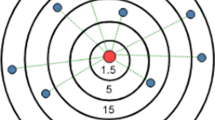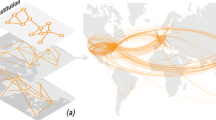Abstract
One of the major trends in academia today is the constant growth of the mobility of scientists. However, the unbalanced mobility of scientific elites can not only lead to institutional hierarchy in research sectors but also result in an “elite circulation” phenomenon. In this study, we collected the information on the institutional mobility of 10,918 laureates of 308 international academic awards, and constructed laureate mobility networks. Furthermore, we examined the structure of these networks by using several statistical approaches. We find that there are hierarchical structures in laureate mobility networks, both in different scientific fields and at different historical periods, indicating that only a few institutions link a higher number of laureates and most institutions at a lower number. In addition, the Gini coefficient shows a higher level of institutional inequality in laureate mobility networks over time.







Similar content being viewed by others
References
Adams, W. (1968). The brain drain. New York: McMillan.
Albarrán, P., Carrasco, R., & Ruiz-Castillo, J. (2017). Geographic mobility and research productivity in a selection of top world economics departments. Scientometrics, 111(1), 241–265.
Allison, P. D., Long, J. S., & Krauze, T. K. (1982). Cumulative advantage and inequality in science. American Sociological Review, 47(5), 615–625.
Arewa, O. B., Morriss, A. P., & Henerson, W. D. (2014). Enduring hierarchies in American legal education. Indiana Law Journal, 89(1), 941.
Ash, M. G., & Söllner, A. (Eds.). (2002). Forced migration and scientific change: Emigre German-speaking scientists and scholars after 1933. Cambridge: Cambridge University Press.
Barabási, A. L., & Albert, R. (1999). Emergence of scaling in random networks. Science, 286(5439), 509–512.
Barnett, G. A., Danowski, J. A., Feeley, T. H., & Stalker, J. (2010). Measuring quality in communication doctoral education using network analysis of faculty-hiring patterns. Journal of Communication, 60(2), 388–411.
Bernal, J. D. (1954). Science in History. London: CA Watts & Co.
Borgatti, S. P., Mehra, A., Brass, D. J., & Labianca, G. (2009). Network analysis in the social sciences. Science, 323(5916), 892–895.
Bourdieu, P. (1984). Distinction: A social critique of the judgement of taste. Cambridge, MA: Harvard University Press.
Brin, S., & Page, L. (1998). The anatomy of a large-scale hypertextual web search engine. Computer Networks and ISDN Systems, 30(1–7), 107–117.
Burris, V. (2004). The academic caste system: Prestige hierarchies in PhD exchange networks. American Sociological Review, 69(2), 239–264.
Cantwell, B. (2011). Transnational mobility and international academic employment: Gatekeeping in an academic competition arena. Minerva, 49(4), 425–445.
Cañibano, C., Otamendi, F. J., & Solís, F. (2011). International temporary mobility of researchers: A cross-discipline study. Scientometrics, 89(2), 653–675.
Clauset, A., Arbesman, S., & Larremore, D. B. (2015). Systematic inequality and hierarchy in faculty hiring networks. Science Advances, 1(1), e1400005.
Clauset, A., Shalizi, C. R., & Newman, M. E. (2009). Power-law distributions in empirical data. SIAM Review, 51(4), 661–703.
Cole, J. R., & Cole, S. (1973). Social stratification in science. Chicago, IL: University of Chicago Press.
Coupé, T. (2003). Revealed performances: Worldwide rankings of economists and economics departments, 1990–2000. Journal of the European Economic Association, 1(6), 1309–1345.
Crane, D. (1969). Social structure in a group of scientists: A test of the "Invisible College" hypothesis. American Sociological Review, 34(3), 335–352.
Cruz-Castro, L., & Sanz-Menéndez, L. (2010). Mobility versus job stability: Assessing tenure and productivity outcomes. Research Policy, 39(1), 27–38.
De Maio, F. G. (2007). Income inequality measures. Journal of Epidemiology & Community Health, 61(10), 849–852.
Gaston, J. (1970). The reward system in British science. American Sociological Review, 35(4), 718–732.
Gastwirth, J. L. (1971). A general definition of the Lorenz curve. Econometrica: Journal of the Econometric Society, 39, 1037–1039.
Gastwirth, J. L. (1972). The estimation of the Lorenz curve and Gini index. The Review of Economics and Statistics, 54, 306–316.
Gleich, D. F. (2015). PageRank beyond the Web. SIAM Review, 57(3), 321–363.
Hagstrom, W. O. (1965). The scientific community. New York: Basic books.
Halffman, W., & Leydesdorff, L. (2010). Is inequality among universities increasing? Gini coefficients and the elusive rise of elite universities. Minerva, 48(1), 55–72.
Jiang, F., & Liu, N. (2018). The hierarchical status of international academic awards in social sciences. Scientometrics, 117(3), 2091–2115.
Jiang, F., & Liu, N. (2019). ‘New wine in old bottles? Examining institutional hierarchy in mobility networks of prestigious awards laureates, 1901–2017’. In Catalano, G., Daraio, C., Gregori, M., Moed, H. F., & Ruocco, G (Eds.) Proceedings of the 17th conference of the international society for scientometrics and informetrics (ISSI 2019), Vol. 1 (pp. 65–74). ISBN: 978-88-3381-118-5.
Katz, D. M., Gubler, J. R., Zelner, J., Bommarito, M. J., II, Provins, E., & Ingall, E. (2011). Reproduction of hierarchy? A social network analysis of the American Law Professoriate. Journal of Legal Education, 61(1), 76.
Mai, B., Liu, J., & González-Bailón, S. (2015). Network effects in the academic market: Mechanisms for hiring and placing PhDs in communication (2007–2014). Journal of Communication, 65(3), 558–583.
Melin, G. (2005). The dark side of mobility: negative experiences of doing a postdoc period abroad. Research Evaluation, 14(3), 229–237.
Merton, R. K. (1968). The Matthew effect in science. Science, 159(3810), 56–63.
Merton, R. K. (1973). The sociology of science: Theoretical and empirical investigations. Chicago: University of Chicago Press.
Merton, R. K. (1988). The Matthew effect in science, II: Cumulative advantage and the symbolism of intellectual property. ISIS: Journal of the History of Science in Society, 79(4), 606–623.
Meyer, J. B. (2008). Network approach versus brain drain: Lessons from the Diaspora. International Migration, 39(5), 91–110.
Mixon, F. G., Torgler, B., & Upadhyaya, K. P. (2017). Scholarly impact and the timing of major awards in economics. Scientometrics, 112(3), 1837–1852.
Morgan, C. A., Economou, J. D., Way, F. S., & Clauset, A. (2018). Prestige drives epistemic inequality in the diffusion of scientific ideas. EPJ Data Science, 40(7), 1–16.
Myers, S. A., Mucha, P. J., & Porter, M. A. (2011). Mathematical genealogy and department prestige. Chaos: An Interdisciplinary Journal of Nonlinear Science, 21(4), 041104.
Pareto, V. (1968). The rise and fall of elites: An application of theoretical sociology. New York: Arno Press.
Petersen, E. B. (2007). Negotiating academicity: Postgraduate research supervision as category boundary work. Studies in Higher Education, 32(4), 475–487.
Price, D. (1963). Little science, big science. New York: Columbia University Press.
Schlagberger, E. M., Bornmann, L., & Bauer, J. (2016). At what institutions did Nobel laureates do their prize-winning work? An analysis of biographical information on Nobel laureates from 1994 to 2014. Scientometrics, 109(2), 723–767.
Storer, N. W. (1966). The social system of science. New York: Holt, Rinehart and Winston.
Tao, Y., Wu, X., & Li, C. (2017). Rawls’ fairness, income distribution and alarming level of Gini coefficient. Economics Discussion Papers, No 2017–67, Kiel Institute for the World Economy. Retrieved from https://www.economics-ejournal.org/economics/discussionpapers/2017-67.
Watts, D. J., & Strogatz, S. H. (1998). Collective dynamics of ‘small-world’ networks. Nature, 393(6684), 440–442.
Wiggins, A., & Sawyer, S. (2012). Intellectual diversity and the faculty composition of iSchools. Journal of the American Society for Information Science and Technology, 63(1), 8–21.
Yuasa, M. (1962). Centre of scientific activity: Its shift from the 16th to the 20th century. Japanese Studies in the History of Science, 1, 57–75.
Zhao, H., & Jiang, G. (1985). Shifting of world's scientific center and scientists' social ages. Scientometrics, 8(1–2), 59–80.
Zheng, J., & Liu, N. (2015). Mapping of important international academic awards. Scientometrics, 104(3), 763–791.
Zhou, J., Zeng, A., Fan, Y., & Di, Z. (2018). Identifying important scholars via directed scientific collaboration networks. Scientometrics, 114(3), 1327–1343.
Zhu, Y., & Yan, E. (2017). Examining academic ranking and inequality in library and information science through faculty hiring networks. Journal of Informetrics, 11(2), 641–654.
Ziman, J. (2002). Real science: What it is and what it means. Cambridge: Cambridge University Press.
Zubieta, A. F. (2009). Recognition and weak ties: Is there a positive effect of postdoctoral position on academic performance and career development? Research Evaluation, 18(2), 105–115.
Zuckerman, H. (1970). Stratification in American science. Sociological Inquiry, 40(2), 235–257.
Zuckerman, H. (1995). Scientific elite: Nobel Laureates in the United States. New Brunswick, NJ: Transaction Publishers.
Author information
Authors and Affiliations
Corresponding authors
Rights and permissions
About this article
Cite this article
Jiang, F., Liu, N.C. New wine in old bottles? Examining institutional hierarchy in laureate mobility networks, 1900–2017. Scientometrics 125, 1291–1304 (2020). https://doi.org/10.1007/s11192-020-03477-7
Received:
Published:
Issue Date:
DOI: https://doi.org/10.1007/s11192-020-03477-7




